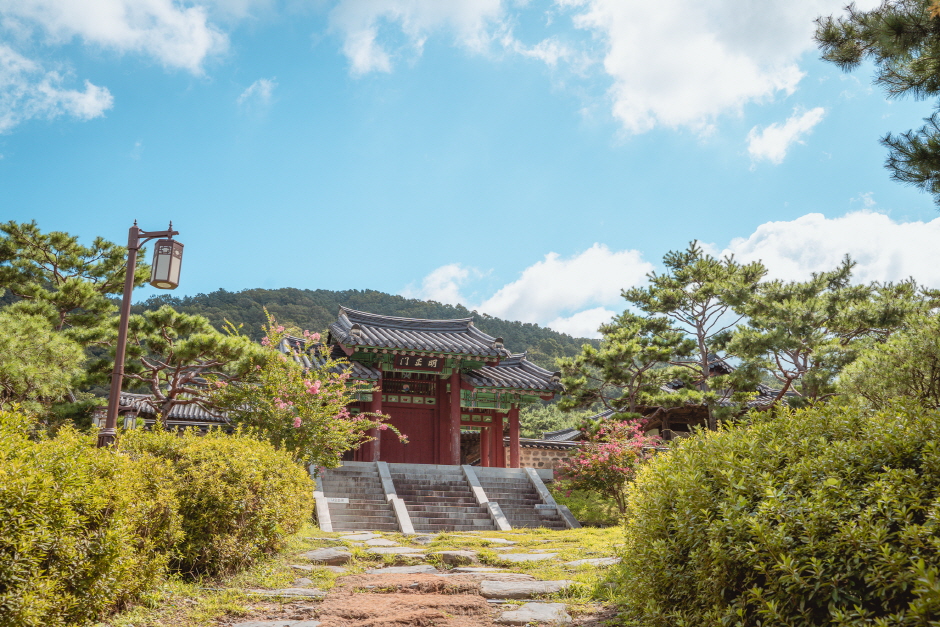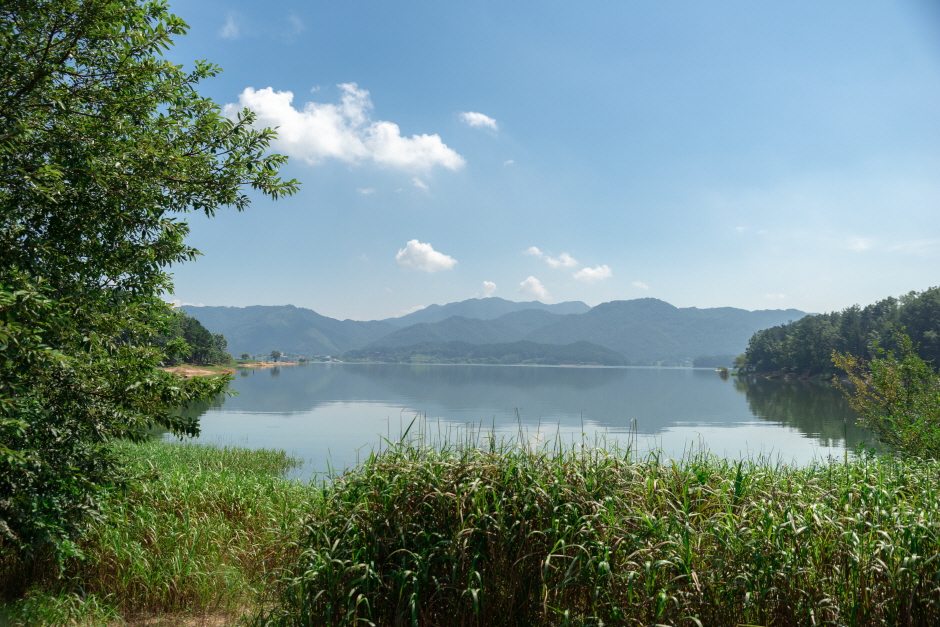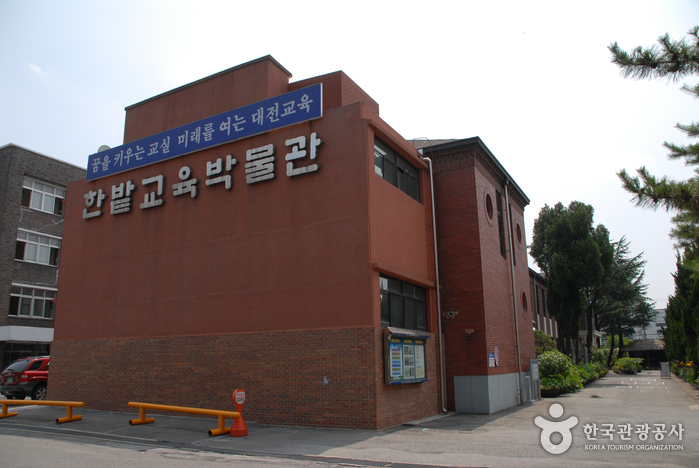E-Mart - Daejeon Terminal Branch [Tax Refund Shop] (이마트 대전터미널)
1.7 Km 0 2024-04-22
1689, Dongseo-daero, Dong-gu, Daejeon
-
Pungnyeon Samgyetang (풍년삼계탕)
2.1 Km 7 2024-02-15
407 Gyejok-ro, Dong-gu, Daejeon
Pungnyeon Samgyetang is a Korean restaurant situated near the Terminal Complex in Dong-gu, Daejeon. Specializing in samgyetang (ginseng chicken soup), it is renowned as a nutritious dish in Korean cuisine. A distinctive feature of their service is the presentation of the food in a hot pot, ensuring warmth until the last bite. The addition of a layer of porridge underneath the chicken enhances the heartiness of this fulfilling meal.
Jeokdeok Sikdang (Main Store) (적덕식당(본점))
2.5 Km 7 2024-02-15
220-3 Uam-ro, Dong-gu, Daejeon
Jeokdeok Sikdang is a Korean restaurant that has been in business since 1974. Its signature dish is yangnyeom jokbal gui (spicy grilled pigs' feet). Customers can choose between regular spicy and spicy flavors, both enhanced by a smoky taste from grilling. Jokbal (braised pigs' feet), known for its chewy texture, is a popular Korean late-night snack and side dish. Additionally, the restaurant offers a dubu ojingeo (stir-fried kimchi, squid and bean curd), similar to duruchigi (stir-fried pork).
Uam Historical Park (우암사적공원)
2.5 Km 11193 2024-02-29
53 Chungjeong-ro, Dong-gu, Daejeon
+82-42-673-9286
Uam Historical Park, situated in the eastern part of Daejeon, is both a cultural heritage site and a park. It was once the place where Uam Song Siyeol (1607-1689), a scholar and government official during the Joseon dynasty, conducted his research and educational activities. The traditional houses established during his time and the relics left by Song Siyeol are still preserved, and visitors can view these artifacts at the historic museum. The park also features a pond within its premises.
Sinseon Manduae (신선만두애)
2.8 Km 8 2024-02-15
1F, 42 Gayang-ro, Dong-gu, Daejeon
Sinseon Manduae, a mandu specialty restaurant, prepares its mandu with domestically sourced ingredients. The restaurant's signature dish is mandu shabu-shabu, featuring handmade mandu boiled in a savory broth. The menu offers two varieties of mandu: meat and kimchi. Additionally, customers have the choice to include beef or seafood in their shabu-shabu. Sinseon Manduae also serves other dishes, including tteong manduguk (rice cake and mandu soup) and steamed mandu.
Daecheongho Obaengni (500-ri) Road (대청호오백리길)
2.9 Km 6733 2021-06-04
34, Cheongaedong-ro, Dong-gu, Daejeon
+82-42-273-5550
Daecheongho Obaengni (500-ri) Road is a 220 kilometer walking path passing through the Daejeon (Dong-gu, Daedeok-gu) and Chungcheongbuk-do (Cheongwon, Okcheon, Boeun) areas. The road passes Daecheongho Lake, small streams, trekking roads, a forest trail, an old path, and much more. The "obaengni" (500-ri) from the name of the road comes from the distance from Seoul or Busan to Daecheongho Lake, which is 500-ri.
Several mountains at an altitude of 200-300 meters and lots of greenery surround Daecheongho Lake. The area also has a date course, a meditation course, a trekking course, a family trip course to experience rural culture and cultural exploration, a bike course and other themed courses. The road was awarded an Asian Townscape Award by the UN-Habitat Program.
Near the road are tourism attractions like the Daecheong Dam Water Culture Center, Daecheongho Sculpture Park, Daecheongho Art Museum, Daecheongho Natural Ecology Center and others. In addition, there are historic cultural tourism spots like Cheongwon Cheongnamdae, Munui Cultural Properities Site, Boeun Songnisan Mountain, Okcheon Dujunbong Peak, and the birthplace of Jeong Jiyong and Yuk Yeongsu.
Conto (꽁뚜식당)
2.9 Km 9 2024-02-15
111 Sintanjin-ro 36beon-gil, Daedeok-gu, Daejeon
Conto is a Chinese restaurant specializing in Bukgyeong ori (grilled Beijing duck). Guests can enjoy the lightly greasy and flavorful grilled duck cooked in a oven. The restaurant provides options for both individual Bukgyeong ori dishes and a set course menu. Given the extended preparation time for the dishes, making a reservation prior to visiting is recommended. Located near a pond, Conto offers a charming atmosphere that enhances the dining experience.
Ossi Kalguksu (오씨칼국수)
3.0 Km 6 2024-02-15
1F, 13 Yetsintanjin-ro, Dong-gu, Daejeon
Ossi Kalguksu is a famous local restaurant known for its kalguksu (noodle soup). The signature dish is sonkalguksu (handmade noodle soup), which features a broth simmered for fourteen hours with anchovies and kelp, and is further enhanced with clams. The noodles are hand-kneaded, offering a particularly chewy texture. The restaurant also serves haemul pajeon (seafood and green onion pancake) and mulchong tang (clam soup) among other dishes.
Hwanghae Myeonok (황해면옥)
3.1 Km 10 2024-02-15
1 Hannam-ro 149beon-gil, Daedeok-gu, Daejeon
Hwanghae Myeonok is a Pyeongyang naengmyeon (Pyeongyang cold buckwheat noodles) specialty restaurant in Daejeon. Its signature dish is the mullaengmyeon (cold buckwheat noodles), known for its tangy umami taste, achieved by mixing meat broth with dongchimi (radish water kimchi) soup. Adding sogogi kimchi bibim (spicy beef and kimchi) to the mullaengmyeon allows diners to enjoy a spicy flavor as well. Being an established restaurant, it has many regular customers and is also a popular spot among local office workers.
Hanbat Museum of Education (한밭교육박물관)
3.3 Km 22261 2021-04-09
96, Uam-ro, Dong-gu, Daejeon
+82-42-670-2200
Hanbat Museum of Education, opened on July 10, 1992, is home to 9 exhibition halls, 3 smaller exhibition areas, and outdoor exhibit areas displaying a total of 27,000 education-related items such as old school textbooks, educational books, student files, stationery, and more. The museum is particularly popular as a fieldtrip destination for local students.
Exhibition chambers at the museum house documents and items that bear witness to the history of education from the olden days (i.e. village Confucian schools) to the present. Also on display are folk materials on the ancient educational institutions of the past and the daily lives of students. Thanks to the extent and variety of its documents, the museum is a great educational institution that not only preserves the history of education in Korea, but also sheds light on hundreds of years of life, tradition, and culture.
The museum building, built on June 8, 1938, is the oldest one in the city. Used as a school and later a military base for the U.N. Peace Corps and North Korean soldiers during the Korean War, the building has never been renovated and still bears the bullet holes and other marks of its tumultuous history. In recognition of its historical importance as a local structure, the museum was designated Cultural Property Material No. 50.




 English
English
 한국어
한국어 日本語
日本語 中文(简体)
中文(简体) Deutsch
Deutsch Français
Français Español
Español Русский
Русский